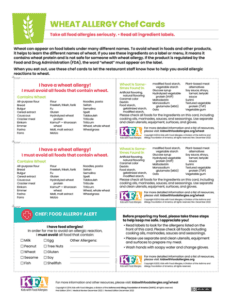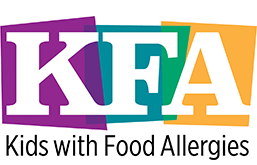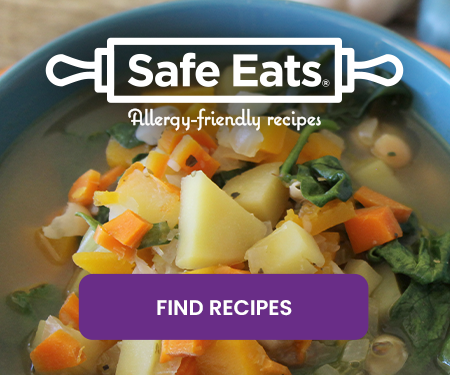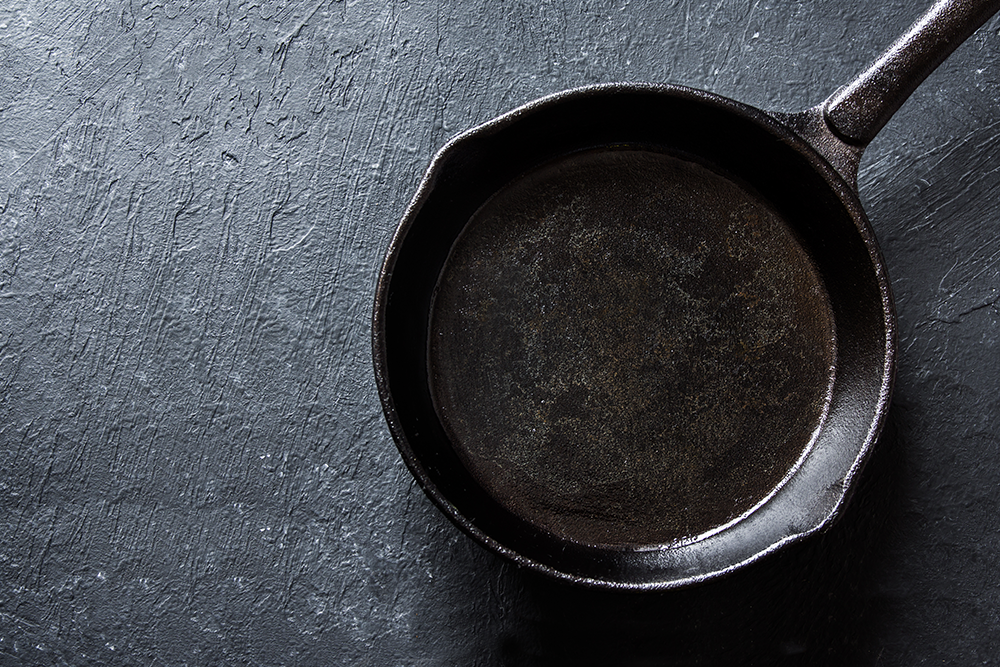Living with Food Allergies

Wheat Allergy
Wheat is one of the most common food allergies worldwide. But there are no good data about how many children are allergic to wheat. Some studies estimate up to 1% of U.S. children have a wheat allergy.
A wheat allergy is an immune system reaction to wheat proteins. Wheat allergy can be severe and life-threatening if not treated promptly. There is no cure for wheat allergy. Wheat allergy can impact a child’s growth and negatively impact their emotional and mental health as well.
It is possible to lead a healthy life without wheat. You can successfully manage wheat allergy with good medical care, knowledge, support, and evidence-based resources. This guide will help you manage it with confidence.
Closed
What are the symptoms of wheat allergy?
There are two types of wheat allergy:
- IgE-mediated – Your immune system makes antibodies called immunoglobulin E (IgE) antibodies. These IgE antibodies react with a certain food, such as wheat, and cause symptoms. This has the potential to cause a severe allergic reaction called anaphylaxis [anna-fih-LACK-sis].
- Non-IgE-mediated − Other parts of the body’s immune system react to wheat in this type of reaction. This reaction causes symptoms too. But it does not involve an IgE antibody. Most of these symptoms affect your digestive tract, such as diarrhea, constipation, weight loss, and bloating.
You can have both IgE-mediated and non-IgE-mediated food allergies. Symptoms in both types of these immune responses may overlap.
When you have an IgE-mediated wheat allergy, you need to be aware of the symptoms of anaphylaxis. Symptoms of anaphylaxis may include hives, vomiting, or trouble breathing. The first-line and main treatment for anaphylaxis is injectable epinephrine.
Signs and symptoms of anaphylaxis include in children, teens, and adults include:
- Skin rash, itching, hives
- Swelling of the lips, tongue, or throat
- Shortness of breath, trouble breathing, wheezing
- Stomach pain, vomiting, diarrhea
- Feeling like something awful is about to happen
Common signs and symptoms of anaphylaxis in infants and toddlers include:2
- Skin rash, itching, hives
- Swelling of the lips, tongue, or throat
- Stomach pain, vomiting, diarrhea, spitting up
- Hiccups
- Arching back, bringing knees to the chest
- Coughing, wheezing
- Rubbing eyes, itchy or red eyes
Wheat can trigger other parts of your immune system to react as well. In people with celiac disease, a specific antibody to gluten (a protein found in wheat, rye, and barley) forms and causes inflammation and damage in the small intestine. The symptoms may look like wheat allergy. Signs and symptoms of wheat intolerance may include:
- Blood in stools, especially in infants
- Loose stools, diarrhea, constipation
- Upset stomach, stomach cramps, bloating
- Failure to thrive (slow to grow or gain weight) or weight loss
How do doctors diagnose wheat allergy?
A doctor will do a physical exam and ask questions about medical history. They will ask about what happens when your child eats wheat. They will want to know how soon symptoms appeared after eating and if and how you treated it and if the treatment was effective.
If they suspect an IgE-mediated wheat allergy, they may order allergy testing to help confirm the diagnosis. A skin prick test or a blood test known as a specific IgE test may be used by your doctor to help diagnose this food allergy. Allergy testing is generally not helpful or suggested for non-IgE-mediated reactions or celiac disease.
The allergist may do another test called an oral food challenge to diagnose a wheat allergy or confirm if you child has outgrown the allergy. There are other conditions that may be triggered by wheat – such as celiac disease or wheat intolerance – so you may also receive a referral to a gastroenterologist (or “GI doctor”).
What is the difference between wheat allergy, wheat intolerance, non-celiac gluten sensitivity, and celiac disease?
You may see these different terms: wheat allergy, wheat intolerance, celiac disease, and non-celiac gluten sensitivity (previously called “gluten intolerance”). These are different conditions that someone may experience when they eat wheat.
A wheat allergy is an IgE-mediated allergic reaction to wheat. Symptoms begin soon after eating wheat – within minutes to hours. Wheat allergy can be severe and life-threatening, causing anaphylaxis.
Celiac disease is an autoimmune condition where the body produces specific antibodies to gluten-containing grains. These antibodies attach the small intestine after you eat gluten. Gluten is a protein found in wheat, rye, and barley. Symptoms may take hours, days, or even weeks to show up. This condition mainly affects your gastrointestinal tract (your gut), can be painful, and can impact growth and nutrition status. Celiac disease is also associated with anemia, osteoporosis, and cancer, especially if it is untreated.
Non-celiac gluten sensitivity is a syndrome of symptoms some people experience after eating gluten-containing grains like wheat. It is not an IgE mediated allergy. Symptoms such as stomach pain, bloating, change in bowel patterns, foggy mind, or feeling tired may occur within a few hours or days. This can overlap with the timing of both wheat allergy and celiac disease. In non-celiac gluten sensitivity, there is no evidence of celiac disease when looking in the blood or at tissue under a microscope. This syndrome may be caused by fermentable, poorly absorbed short-chain carbohydrates (fermentable oligo-, di-, and monosaccharides and polyols (FODMAP) and not gluten itself.
Food protein-induced enterocolitis – also called FPIES – is non-IgE-mediated allergy that can be triggered by various foods, including wheat, cow’s milk, soy, and cereal grains. This is a delayed food allergy reaction that usually starts two to four hours after the your child eats the food allergen. Symptoms include nausea, vomiting, abdominal pain, and diarrhea. It is not IgE-mediated. It can be severe and life-threatening if your child does not get proper medical treatment. Treatment consists of removing food triggers, hydration, and management of gastrointestinal symptoms.
How can I prevent wheat allergy reactions?
Wheat can be found in almost any type of food. Foods that contain wheat include breads, baked goods, pasta, meat that is breaded, and so much more.
The only way to avoid an allergic reaction is to completely remove wheat from your child’s diet. This includes all wheat products.
But you can successfully manage wheat allergy with education and an allergy management plan. This can be done by:
- Working with your doctor
- Reading labels
- Being aware of cross-contact (when foods come into contact with each other and may transfer an allergen into a food that shouldn’t have it)
- Clearly communicating with school staff, people who prepare your food, and babysitters and other caregivers
How do I read labels for wheat?
Under the Food Allergen Labeling and Consumer Protection Act (FALCPA), food companies must label their products clearly if they contain wheat.
When reading labels for wheat, look for wheat to be labeled either in parentheses after an ingredient in the ingredient list or in a statement under the ingredient list. For example:
- Flour (wheat)
- Contains: Wheat
Sometimes wheat may appear in bold print in the ingredient list too. To avoid wheat in foods and other products, it helps to learn the different names of wheat (see our list below).
Some food companies put advisory statements on their labels known as “precautionary allergen labeling (PAL). They may say “may contain wheat” or “made in a facility with wheat.” FALCPA does not require these statements. They can be confusing and may not tell you the actual risk of the product. If you have questions about advisory labels, talk with your doctor.
If a food item does not have a label, you can’t read it, or you have any doubts, don’t eat it. Always read the entire label every time. Food companies may change their recipes.
The FALCPA does not apply to all foods and everything that may contain wheat though. This means wheat could be “hidden” in products or listed under other names. Or you may not be able to find out the exact ingredients. These foods and products do not have to have wheat clearly listed or labeled and may contain wheat:
- Arts and crafts supplies
- Prescription and over-the-counter drugs
- Cosmetics and personal care items (such as, makeup, lotions, and soaps)
- Alcohol
- Toys
- Pet food
- Food served in restaurants, cafeterias, or other food service providers
There are many different names for wheat. When shopping and cooking, have a list of the different names of wheat on hand to check food packages for wheat ingredients. We have compiled a list of the different names of wheat below. You can also download and print Kids with Food Allergies’ (KFA) Guide to Managing Wheat Allergy and Chef Cards.
Most states in the U.S. do not have regulations regarding food allergies and restaurants. Ingredients in restaurant foods may vary. Cross-contact is also more likely. Many restaurants are becoming more food allergy aware though. Look for places that have food allergy policies and allergy menus. Give the staff a chef card that alerts them to your allergy and lists wheat ingredients for them to watch for.
Wheat ingredient list
If you see these ingredients on a label, it means it contains wheat and is not safe for someone with wheat allergy. If the product is regulated by the Food and Drug Administration (FDA), the word “wheat” must appear on the label. All labels should be read carefully before consuming a product, even if your child has safely eaten it in the past.
CONTAINS WHEAT
Bread — any type made with white flour, wheat flour; bread crumbs
Bulgur
Cereal extract
Couscous
Cracker meal
Einkorn
Emmer – also known as farro
Farina
Farro
Flour — all-purpose, atta, bread, bromated, cake, club, common, durum, einkorn, emmer, enriched, farina, graham, ground, high gluten, high protein, instant pastry, kamut, maida, phosphated, plain, self-rising, semolina, soft wheat, spelt, steel ground, stone, triticale, triticum, unbleached, white, whole wheat
Freekeh, frikeh, farik
Fu
Gluten — wheat gluten, vital gluten, vital wheat gluten, fu
Hydrolyzed wheat protein
Kamut ® — khorasan wheat
Malt, malt extract
Matzo — Matzo meal (also spelled as matzoh, matzah, or matza)
Noodles, pasta
Seitan
Semolina
Spelt
Tabbouleh
Triticale
Triticum
Wheat, whole wheat — wheat berries, wheat bran, whole wheat bread, whole wheat flour, wheat germ, wheat germ oil, wheat protein isolate, wheat starch, wheat sprouts, sprouted wheat
Wheatgrass
Note: Buckwheat is not related to wheat and is considered safe for people with wheat allergy.
WHEAT IS SOMETIMES FOUND IN
Artificial flavoring, natural flavoring
Caramel color
Dextrin
Food starch*, gelatinized starch, modified starch, modified food starch, vegetable starch
Glucose syrup
Hydrolyzed vegetable protein (HVP)
Maltodextrin
Monosodium glutamate, MSG
Oats**
Plant-based meat alternatives
Soy sauce, shoyu, tamari, teriyaki sauce
Surimi
Textured vegetable protein
Vegetable gum
However, if the product is regulated by the FDA, the word “wheat” must appear on the label.
*Unless otherwise stated on the food label, the single word “starch” in an ingredient list means corn starch. Starches from other sources should be designated by some non-misleading term that indicates the source of such starch, for example, “wheat starch.”
**Wheat-free and gluten-free oats can be found from special suppliers.
BOTANICAL NAMES OF WHEAT (SOMETIMES FOUND IN PERSONAL CARE PRODUCTS)
Club wheat (Triticum compactum Host.)
Common wheat (Triticum aestivum L.)
Durum wheat (Triticum durum Desf.)
Einkorn (Triticum monococcum L. subsp. monococcum)
Emmer (Triticum turgidum L. subsp. dicoccon (Schrank) Thell.)
Kamut (Triticum polonicum L.)
Semolina (Triticum durum Desf.)
Spelt (Triticum spelta L.)
Triticale ( x Triticosecale ssp. Wittm.)
Triticum: Triticum aestivum L., Triticum durum Desf., Triticum compactum Host., Triticum spelta L., Triticum durum Desf., Triticum monococcum L. subsp. monococcum, Triticum turgidum L. subsp.dicoccon (Schrank) Thell., Triticum polonicum L., and x Triticosecale spp. Wittm.
 Download or Order Print Copies: “A Guide to Managing Wheat Allergy” (Includes Chef Cards and More) |
 Download or Order Print Copies: Wheat Allergy Chef Cards |
What does "gluten-free" mean for people with wheat allergy?
The term “gluten-free” is a voluntary term food manufacturers may put on labels. Most gluten-free foods are also wheat free. Wheat can be processed to remove the gluten though, so take care to read all labels for the presence of wheat.
From the FDA: On August 2, 2013, FDA issued a final rule defining “gluten-free” for food labeling, which helps consumers, especially those living with celiac disease, be confident that items labeled “gluten-free” meet a defined standard for gluten content. “Gluten-free” is a voluntary claim that can be used by food manufacturers on food labels if they meet all the requirements of the regulations.
The rule specifies, among other criteria, that any foods that carry the label “gluten-free,” “no gluten,” “free of gluten,” or “without gluten” must contain less than 20 parts per million (ppm) of gluten. This level is the lowest that can be reliably detected in foods using scientifically valid methods.
Besides the limit of gluten to 20 ppm, the rule permits labeling a food “gluten-free”, if the food does not contain:
- An ingredient that is any type of wheat, rye, barley, or cross-breeds of these grains,
- An ingredient derived from these grains that has not been processed to remove gluten, or,
- An ingredient derived from these grains that has been processed to remove gluten, but results in the food containing more than 20 ppm of gluten
Whether a food is manufactured to be free of gluten or by nature is free of gluten, it may bear a “gluten-free” labeling claim if it meets all FDA requirements for a gluten-free food. Some foods and beverages, such as bottled spring water, fruits, vegetables, and eggs, are naturally gluten-free. However, because a “gluten-free” claim isn’t required to be on a food package, it may not appear even if the food is, in fact, gluten-free.
On August 12, 2020, the FDA issued a final rule on the gluten-free labeling of fermented or hydrolyzed foods. It covers foods such as yogurt, sauerkraut, pickles, cheese, green olives, FDA-regulated beers and wines (e.g., generally those with less than 7 percent alcohol), and hydrolyzed plant proteins used to improve flavor or texture in processed foods such as soups, sauces, and seasonings. The rule does not change the definition of “gluten-free” but establishes compliance requirements for these hydrolyzed and fermented foods. It also includes a discussion of how FDA will verify compliance for distilled foods such as vinegar.
How can I make sure my child gets enough nutrition on a wheat-free diet?
Grains contain protein, and when fortified, a good variety of vitamins and minerals. Some minerals in grains include B vitamins and iron. The milling process for grains can also remove important nutrients. So, make sure you choose fortified and enriched grains that replace these nutrients. A serving or two of an enriched and fortified grain at each meal will contribute to meeting important nutritional needs for B vitamins, folacin, and iron.
| NUTRIENTS LOST WHEN AVOIDING WHEAT |
SUGGESTED ALTERNATE SOURCES (if you are not allergic) |
| Protein, B Vitamins, Iron | Protein foods: meats, fish, poultry, legumes, eggs, dairy (if safe for your child); fruit, vegetables, leafy greens, fortified alternate grain products (rice, corn, oats, barley, buckwheat) |
Does my child need to avoid foods related to wheat?
There is about a 20% chance your child could have an allergy to more than one grain.2 Examples of grains other than wheat are rye, barley, rice, corn, or oats. If your child does not have symptoms to other grains, you do not need to remove them from their diet.
What can I substitute for wheat in recipes?
Look for fortified and enriched grains to provide the nutrients missed by avoiding wheat. You can substitute flours from alternate grains in recipes to provide the same nutrients as wheat. Using wheat-free alternative flours can be tricky. Follow recipes carefully and become familiar with using alternative grains in recipes.
Learn more about using wheat substitutes.
How can I prevent wheat allergy reactions from cross-contact?
Cross-contact occurs when a food allergen comes in contact with food or an item not intended to contain that allergen. There are several precautions you should take to avoid food mix-ups and accidental cross-contact.
If you have both “safe” and “unsafe” versions of similar items (like wheat pasta and wheat-free/gluten-free pasta) in your home, take steps to make sure they are easily marked. If the containers look the same, create a system for your family to prevent accidents. It may be helpful to use colored stickers or to store the food with the allergen on a different shelf.
When you’re cooking, use separate utensils and kitchenware. For example, don’t use the same knife to cut a wheat bread sandwich as you use to cut a sandwich made without wheat. You can find more tips on how to prevent allergic reactions in our article: 12 Tips for Avoiding Cross-Contact of Food Allergens
Will my child outgrow a wheat allergy?
Around 65% (two out of three) kids with wheat allergy outgrow it by age 12.3 But for some people, a wheat allergy can be life-long.
Is there a treatment for wheat allergy?
Currently, there are no FDA-approved treatments for wheat allergy (as of December 2022). The best way to prevent wheat allergy reactions is to avoid wheat completely. But some research is being done on wheat allergy treatments, such as oral immunotherapy (OIT).
Many doctors have been offering OIT treatment using foods in various forms, such as a liquid, flour, or the actual food itself. These methods are not approved by the FDA. Talk with your child’s doctor about the most appropriate OIT option for your child. The FDA is looking at other food allergy treatments to fast track through the approval process to address this unmet need in the food allergy community.
There are many known side effects or possible adverse reactions to OIT. Talk with your allergist to see if this treatment might be right for your child and family.
Food Allergy Fact
People can develop food allergies at any age, but they most often begin in the first two years of life.
Medical Review: December 2022 by John James, MD
References
1. Pistiner, M., Mendez-Reyes, J. E., Eftekhari, S., Carver, M., Lieberman, J., Wang, J., & Camargo, C. A. (2021). Caregiver-reported presentation of severe food-induced allergic reactions in infants and toddlers. The Journal of Allergy and Clinical Immunology: In Practice, 9(1). https://doi.org/10.1016/j.jaip.2020.11.005
2. Sicherer, SH. (2002). Clinical implications of cross-reactive food allergens. Journal of Allergy and Clinical Immunology , Volume 108 , Issue 6 , 881 – 890. Retrieved online on December 15, 2022, at http://www.jacionline.org/article/S0091-6749(01)63295-0/fulltext.
3. American College of Allergy, Asthma & Immunology. (n.d.). Wheat & Gluten Allergy | Symptoms & Treatment. American College of Allergy, Asthma & Immunology. Retrieved December 14, 2022, from https://acaai.org/allergies/allergic-conditions/food/wheat-gluten/















